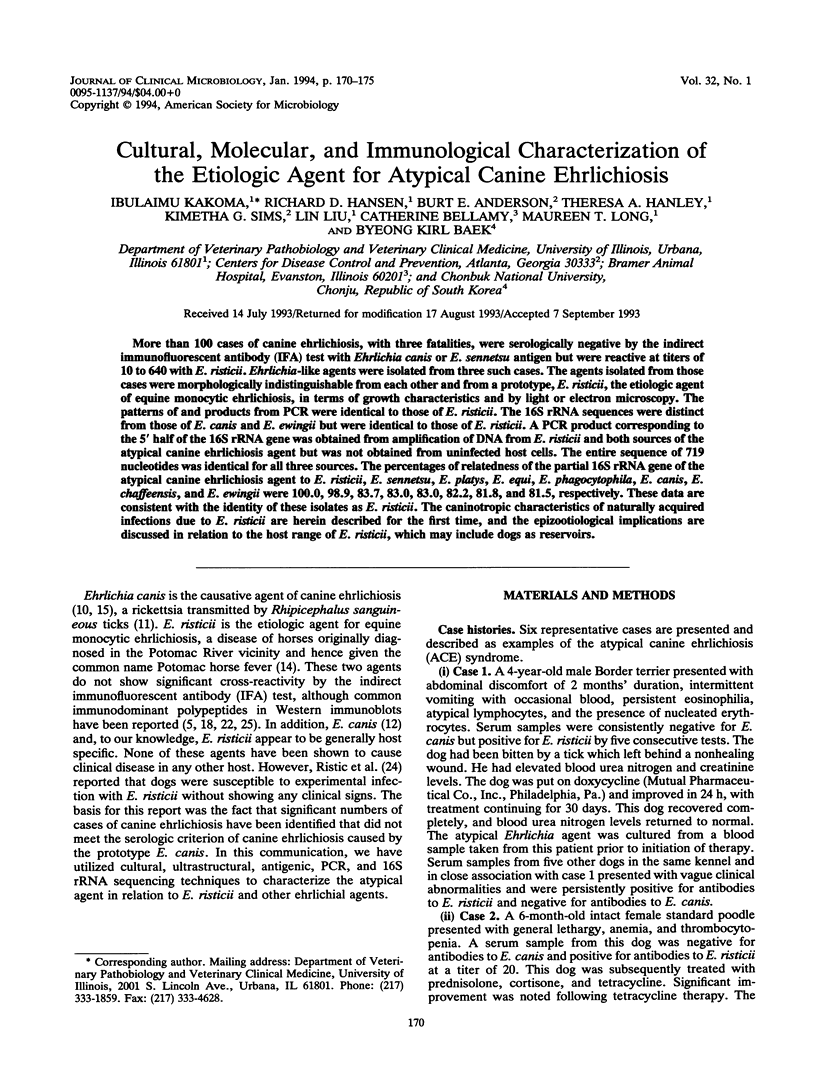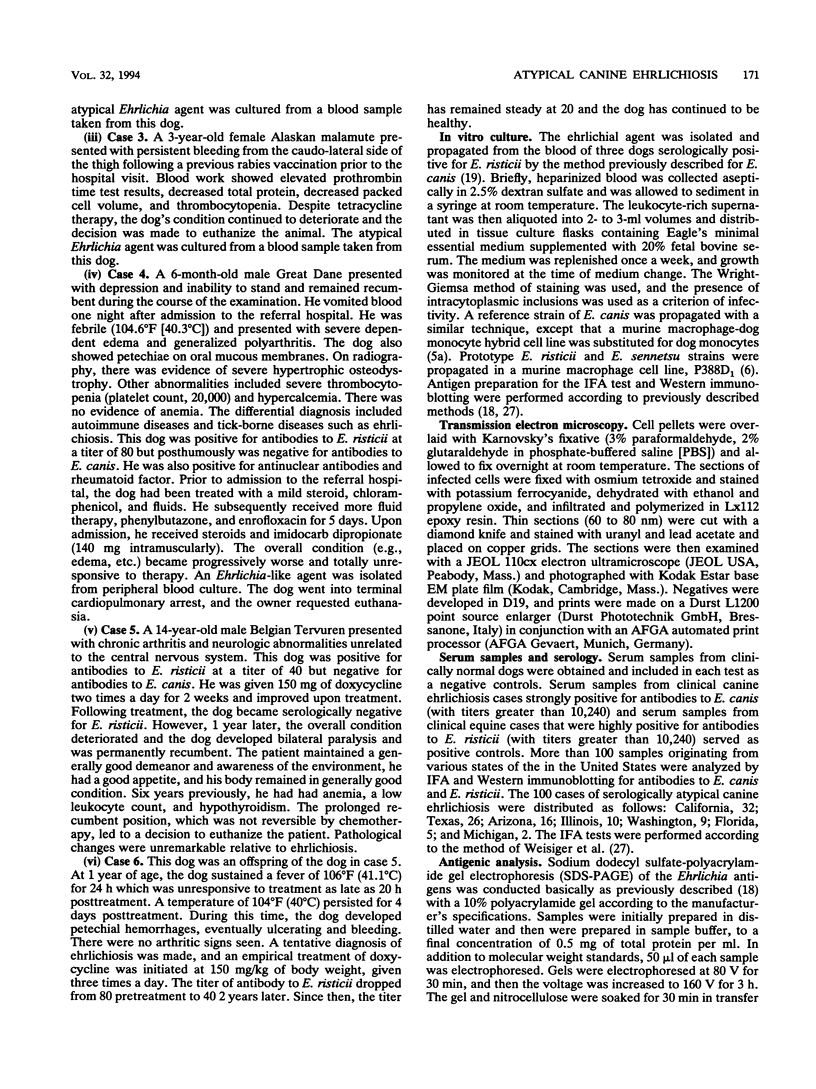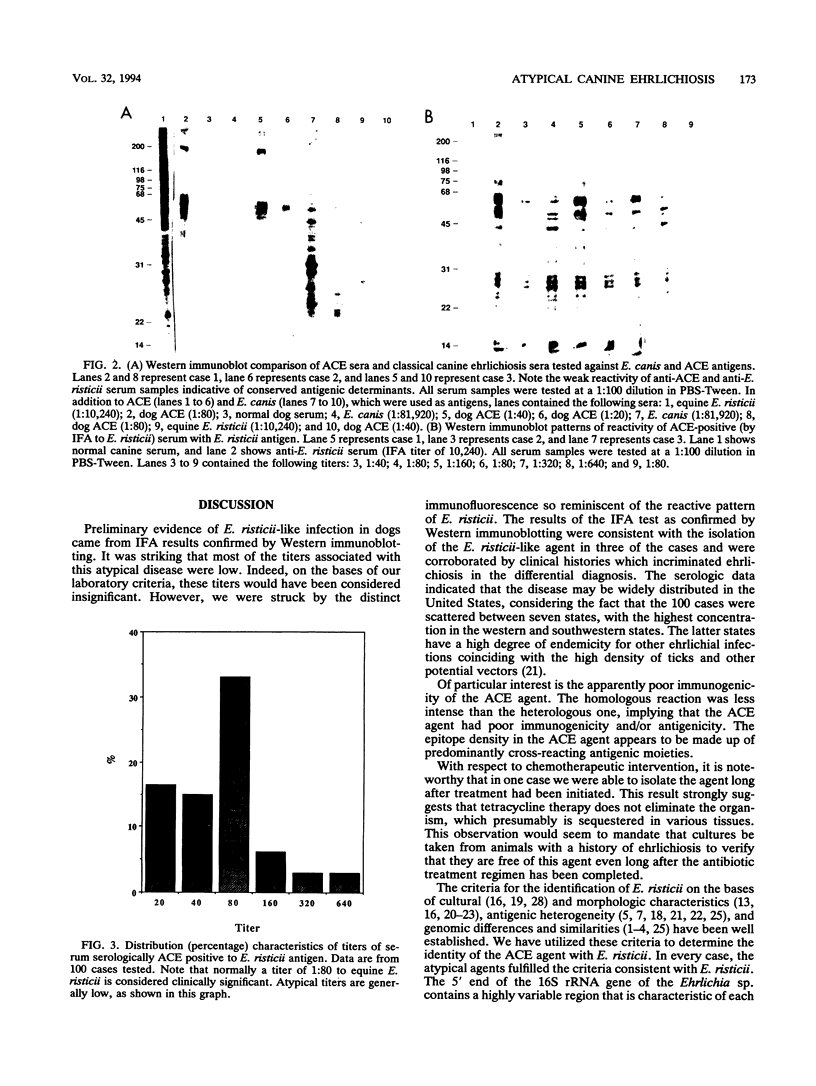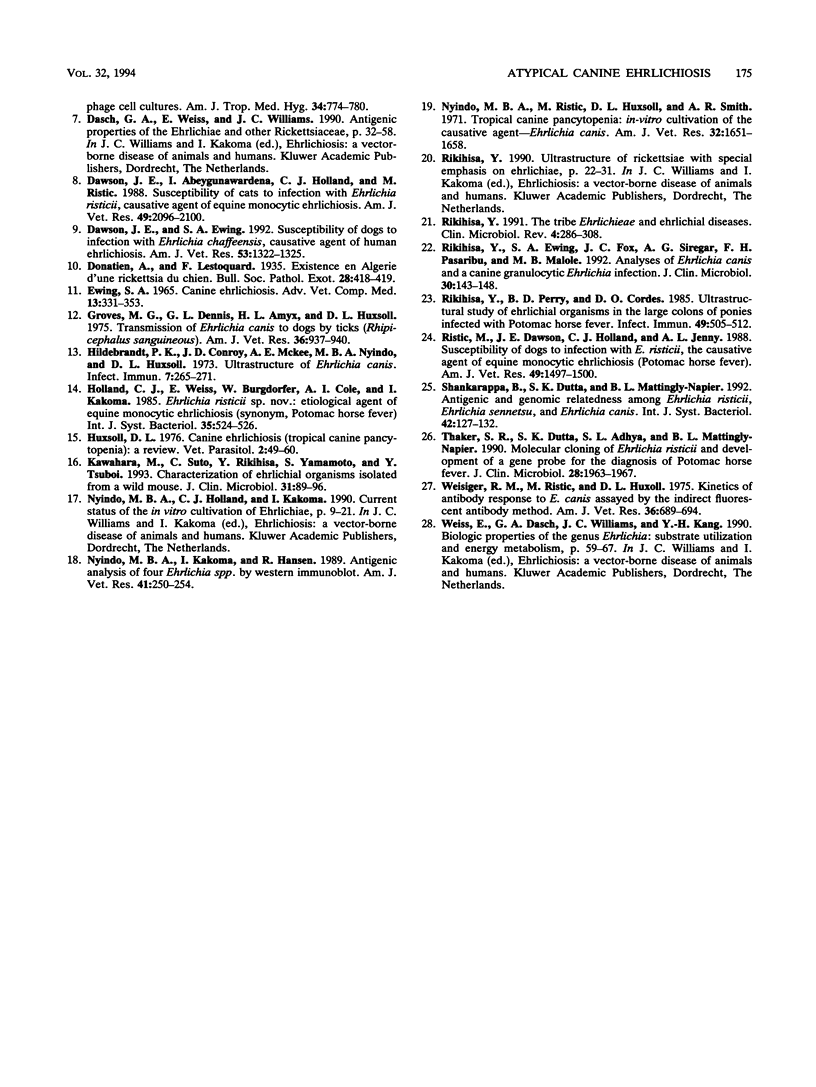Abstract
More than 100 cases of canine ehrlichiosis, with three fatalities, were serologically negative by the indirect immunofluorescent antibody (IFA) test with Ehrlichia canis or E. sennetsu antigen but were reactive at titers of 10 to 640 with E. risticii. Ehrlichia-like agents were isolated from three such cases. The agents isolated from those cases were morphologically indistinguishable from each other and from a prototype, E. risticii, the etiologic agent of equine monocytic ehrlichiosis, in terms of growth characteristics and by light or electron microscopy. The patterns of and products from PCR were identical to those of E. risticii. The 16S rRNA sequences were distinct from those of E. canis and E. ewingii but were identical to those of E. risticii. A PCR product corresponding to the 5' half of the 16S rRNA gene was obtained from amplification of DNA from E. risticii and both sources of the atypical canine ehrlichiosis agent but was not obtained from uninfected host cells. The entire sequence of 719 nucleotides was identical for all three sources. The percentages of relatedness of the partial 16S rRNA gene of the atypical canine ehrlichiosis agent to E. risticii, E. sennetsu, E. platys, E. equi, E. phagocytophila, E. canis, E. chaffeensis, and E. ewingii were 100.0, 98.9, 83.7, 83.0, 83.0, 82.2, 81.8, and 81.5, respectively. These data are consistent with the identity of these isolates as E. risticii. The caninotropic characteristics of naturally acquired infections due to E. risticii are herein described for the first time, and the epizootiological implications are discussed in relation to the host range of E. risticii, which may include dogs as reservoirs.
Full text
PDF





Images in this article
Selected References
These references are in PubMed. This may not be the complete list of references from this article.
- Anderson B. E., Dawson J. E., Jones D. C., Wilson K. H. Ehrlichia chaffeensis, a new species associated with human ehrlichiosis. J Clin Microbiol. 1991 Dec;29(12):2838–2842. doi: 10.1128/jcm.29.12.2838-2842.1991. [DOI] [PMC free article] [PubMed] [Google Scholar]
- Anderson B. E., Greene C. E., Jones D. C., Dawson J. E. Ehrlichia ewingii sp. nov., the etiologic agent of canine granulocytic ehrlichiosis. Int J Syst Bacteriol. 1992 Apr;42(2):299–302. doi: 10.1099/00207713-42-2-299. [DOI] [PubMed] [Google Scholar]
- Anderson B. E., Sumner J. W., Dawson J. E., Tzianabos T., Greene C. R., Olson J. G., Fishbein D. B., Olsen-Rasmussen M., Holloway B. P., George E. H. Detection of the etiologic agent of human ehrlichiosis by polymerase chain reaction. J Clin Microbiol. 1992 Apr;30(4):775–780. doi: 10.1128/jcm.30.4.775-780.1992. [DOI] [PMC free article] [PubMed] [Google Scholar]
- Biswas B., Mukherjee D., Mattingly-Napier B. L., Dutta S. K. Diagnostic application of polymerase chain reaction for detection of Ehrlichia risticii in equine monocytic ehrlichiosis (Potomac horse fever). J Clin Microbiol. 1991 Oct;29(10):2228–2233. doi: 10.1128/jcm.29.10.2228-2233.1991. [DOI] [PMC free article] [PubMed] [Google Scholar]
- Brouqui P., Dumler J. S., Raoult D., Walker D. H. Antigenic characterization of ehrlichiae: protein immunoblotting of Ehrlichia canis, Ehrlichia sennetsu, and Ehrlichia risticii. J Clin Microbiol. 1992 May;30(5):1062–1066. doi: 10.1128/jcm.30.5.1062-1066.1992. [DOI] [PMC free article] [PubMed] [Google Scholar]
- Cole A. I., Ristic M., Lewis G. E., Jr, Rapmund G. Continuous propagation of Ehrlichia sennetsu in murine macrophage cell cultures. Am J Trop Med Hyg. 1985 Jul;34(4):774–780. doi: 10.4269/ajtmh.1985.34.774. [DOI] [PubMed] [Google Scholar]
- Dawson J. E., Abeygunawardena I., Holland C. J., Buese M. M., Ristic M. Susceptibility of cats to infection with Ehrlichia risticii, causative agent of equine monocytic ehrlichiosis. Am J Vet Res. 1988 Dec;49(12):2096–2100. [PubMed] [Google Scholar]
- Dawson J. E., Ewing S. A. Susceptibility of dogs to infection with Ehrlichia chaffeensis, causative agent of human ehrlichiosis. Am J Vet Res. 1992 Aug;53(8):1322–1327. [PubMed] [Google Scholar]
- Ewing S. A. Canine ehrlichiosis. Adv Vet Sci Comp Med. 1969;13:331–353. [PubMed] [Google Scholar]
- Groves M. G., Dennis G. L., Amyx H. L., Huxsoll D. L. Transmission of Ehrlichia canis to dogs by ticks (Rhipicephalus sanguineus). Am J Vet Res. 1975 Jul;36(7):937–940. [PubMed] [Google Scholar]
- Hildebrandt P. K., Conroy J. D., McKee A. E., Nyindo M. B., Huxsoll D. L. Ultrastructure of Ehrlichia canis. Infect Immun. 1973 Feb;7(2):265–271. doi: 10.1128/iai.7.2.265-271.1973. [DOI] [PMC free article] [PubMed] [Google Scholar]
- Kawahara M., Suto C., Rikihisa Y., Yamamoto S., Tsuboi Y. Characterization of ehrlichial organisms isolated from a wild mouse. J Clin Microbiol. 1993 Jan;31(1):89–96. doi: 10.1128/jcm.31.1.89-96.1993. [DOI] [PMC free article] [PubMed] [Google Scholar]
- Nyindo M. B., Ristic M., Huxsoll D. L., Smith A. R. Tropical canine pancytopenia: in vitro cultivation of the causative agent--Ehrlichia canis. Am J Vet Res. 1971 Nov;32(11):1651–1658. [PubMed] [Google Scholar]
- Nyindo M., Huxsoll D. L., Ristic M., Kakoma I., Brown J. L., Carson C. A., Stephenson E. H. Cell-mediated and humoral immune responses of German Shepherd Dogs and Beagles to experimental infection with Ehrlichia canis. Am J Vet Res. 1980 Feb;41(2):250–254. [PubMed] [Google Scholar]
- Rikihisa Y., Ewing S. A., Fox J. C., Siregar A. G., Pasaribu F. H., Malole M. B. Analyses of Ehrlichia canis and a canine granulocytic Ehrlichia infection. J Clin Microbiol. 1992 Jan;30(1):143–148. doi: 10.1128/jcm.30.1.143-148.1992. [DOI] [PMC free article] [PubMed] [Google Scholar]
- Rikihisa Y., Perry B. D., Cordes D. O. Ultrastructural study of ehrlichial organisms in the large colons of ponies infected with Potomac horse fever. Infect Immun. 1985 Sep;49(3):505–512. doi: 10.1128/iai.49.3.505-512.1985. [DOI] [PMC free article] [PubMed] [Google Scholar]
- Rikihisa Y. The tribe Ehrlichieae and ehrlichial diseases. Clin Microbiol Rev. 1991 Jul;4(3):286–308. doi: 10.1128/cmr.4.3.286. [DOI] [PMC free article] [PubMed] [Google Scholar]
- Ristic M., Dawson J., Holland C. J., Jenny A. Susceptibility of dogs to infection with Ehrlichia risticii, causative agent of equine monocytic ehrlichiosis (Potomac horse fever). Am J Vet Res. 1988 Sep;49(9):1497–1500. [PubMed] [Google Scholar]
- Shankarappa B., Dutta S. K., Mattingly-Napier B. L. Antigenic and genomic relatedness among Ehrlichia risticii, Ehrlichia sennetsu, and Ehrlichia canis. Int J Syst Bacteriol. 1992 Jan;42(1):127–132. doi: 10.1099/00207713-42-1-127. [DOI] [PubMed] [Google Scholar]
- Thaker S. R., Dutta S. K., Adhya S. L., Mattingly-Napier B. L. Molecular cloning of Ehrlichia risticii and development of a gene probe for the diagnosis of Potomac horse fever. J Clin Microbiol. 1990 Sep;28(9):1963–1967. doi: 10.1128/jcm.28.9.1963-1967.1990. [DOI] [PMC free article] [PubMed] [Google Scholar]
- Weisiger R. M., Ristic M., Huxsoll D. L. Kinetics of antibody response to Ehrlichia canis assayed by the indirect fluorescent antibody method. Am J Vet Res. 1975 May;36(5):689–694. [PubMed] [Google Scholar]





